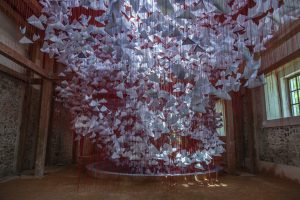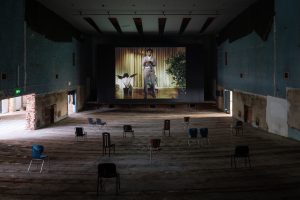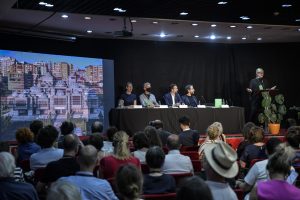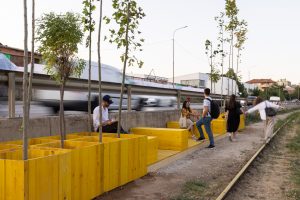Jeta Xharra enjoys her first encounter with the nomadic biennale that has changed many people’s way of seeing their unlovely capital, Prishtina
In July this year, we entered the Grand Hotel through the 32-square-metre damp and dark parking lot, built in 1974, which, like the hotel itself, has been left neglected ever since.
If you follow a GREEN dot from this parking lot, it leads you to a half-hidden narrow corridor where you have to open heavy drapes, and so present your family with their first encounter of Manifesta.
In the imaginations of my 10- and 12-year-old kids, Manifesta was built up to be some sort of feast, as festa in Albanian means, literally, a feast. What they got instead, behind these drapes, is a space that looks like a gigantic toilet or a labyrinth of prison cells with old square white tiles where the sign “Off Season Tourism Agency Prishtina” awaits them.
They are revolted and protest that this is not their idea of art, and start mentioning how hungry they suddenly feel. I, on the other hand, was enjoing the unpredictibility of our first encounter with this nomadic biennale, as it feels like I’d just entered Twin Peaks or some other David Lynch film.
I understood that Manifesta, a contemporary art installation in 25 different locations in Prishtina, reflects the post-Covid mood that is dominating contemporary art in other biennales, such as Venice, where the Italian pavilion looked similar to the Rilindja building.

Brutal Times, 2022 , © Cevdet Erek Photo © Manifesta 14 Prishtina Ivan Erofeev
“Rilindja”, Albanian for “Renaissance”, is the former printing house of similar size to the Grand Hotel parking, where the main art installation is Cevdet Erek’s eerie sounds of printing machines and red neon lighting that comes and goes from the basement, symbolising a bygone era of print in a country where people who were once proud to have won the right of printing in Albanian, but have stopped printing newspapers entirely, and can only read them online.
In this frame of mind, the lynchian, creepy, isolated and hardly used corridor of the Grand Hotel behind the drapes is an incredibly imaginative setting to place the artwork of a collective of artists and cultural workers from Kosovo, Albania, Romania and Germany who devised the video installations in the early stages of the pandemic, filming the abandoned, but normally overrun by tourists, Albanian resort of Radhime.
I suddenly start falling in love with corners of my hometown which I normally try to avoid, and I understand that is exactly the trick that Manifesta is trying to pull on all of us locals who have experienced a trauma with some parts of our city.
For me, this same floor of the Grand Hotel, where Manifesta has placed the Off Season Tourism Agency, hosts the lobby and bar where “Arkan” paramilitaries used to roam and drink after a “working day” of burning, looting, killing and pillaging Kosovo villages for fun in the late-Nineties.
Some, like myself, who used to work as translators and fixers for international TV crews during the war, had to come through this Grand Hotel lobby and make it to the editing rooms of the BBC, CNN, ITV and Channel 4, since hotels in Prishtina were sparse and the rooms of this hotel had to turn into TV editing rooms where journalists would cut their TV news reportage and then send it for broadcasting around the world.

When the sun goes away we paint the sky, 2022, © Manifesta 14 Prishtina, Petrit Halilaj. Photo Hana Agimi, YII Çitaku
As the hotel rooms were turned into offices for international media during the war, the authorities at the time saw it fit to turn the first floor of the Grand Hotel to a “Serbian Media Center”, which was a de-facto propaganda base for Slobodan Milosevic that was supposed to “inform” all the international journalists staying in the Grand of the “accurate” side of the story.
How pleasantly vengeful that this former propaganda space, almost a quarter-of-a-century later, hosts the artwork of some amazing Kosovo women such as those who run Foundation 17 and Majlinda Hoxha, the Kosovo Albanian artist and photographer who has interviewed and photographed Grand Hotel workers about their experiences not only through the former Yugoslav times but through the troubles with the somewhat criminal process of Grand Hotel privatisation that failed in post-war Kosovo.
Through this process, worried that works of art that were displayed in Hotel Grand from the Seventies were going to be sold as scrap material in the post-2006 privatisation, workers tried to save paintings, prints and tapestries that were collected and exhibited in the Grand Hotel, locked up in one hotel room.
They made a rule that whenever that room was opened, there had to be at least two people there, one with the room key, and another one with a drill, in order to unscrew an additional lock that would only open by drilling, a process which was documented in a BIRN research last year.
No wonder this hotel has captured the imagination of this festival of contemporary art that has moved to a different city every two years since 1996.
Headed by a tour-de-force, Hedwig Fijen, a Dutch woman who does not take “no” for an answer, a decision was made to turn this grim hotel reviewed in 2018 in The New York Times as “deserted, a maze of dimly lit corridors that are littered with pigeon feathers, strung with cobwebs”, as the key feature of its lively and creative exhibition that ran through seven floors, literally turning rubble into art from July till October this year.
Driton Selmani, one of the local artists exhibiting on the topic of Love in the Grand Hotel, coined the notion that Manifesta has changed how local citizens view their city.

Tell me your Story, 2022 , © Chiharu Shiota. Photo © Manifesta 14 Prishtina, Majlinda Hoxha
When speaking to Catherine Nichols, the key Manifesta curator in a discussion in September, Selmani said that Prishtina feels like a former lover that he is rediscovering for the first time with a map, referencing the fact that 25 locations where Manifesta exhibits were drawn on a green map for a city that has never been served by a public map of any sorts and, has never been green.
The discussion was held in the Center for Narrative Practice, a former neglected children’s library that was revamped by Manifesta, and the conversation between Nichols and Selmani was about whether we can apply love in politics as a method to cure society’s defects in the same way as it cures people’s moods.
The conversation went on in such a direction that Nichols argued that she saw an incredible potential in Prishtina’s energy and the abundance of the local artists who come from here, presenting it as her current “lover” and not a past one.
The energy and a vibrant cadre of contemporary artists who are largely famous abroad, and are now exhibiting in Manifesta, are among the reasons why Prishtina was chosen to host Manifesta, when all other Balkan capitals would have probably provided better infrastructure for this biennale.
According to Fijen, of all the Manifestas held so far in the world, this one has had most participation by local artists. Of over 100 participants, 37 per cent are from Kosovo and a further 23 per cent from the Western Balkans. The irony is that, because the local artists are largely exhibiting abroad and Kosovars still do not have visa-free travel in Europe, most local people have never seen the work of local artists displayed on such a scale before as are being exhibited now in this international biennale.
In addition, Manifesta has brought in tens of thousands of art lovers to a place which is normally visited mainly by international bureaucrats with an agenda.
Considering that Kosovars are no strangers to having international initiatives experimented on them, what feels unusual in Manifesta’s case is that it did what it said it would do – amplify local voices and local experiences to explore “how to tell stories otherwise”, as its motto says.
Society in Kosovo has often been made to feel like it is a part of a political experiment, considering that four different international missions have tried to run parts of Kosovo society and politics since 1999.
First there was United Nations Mission in Kosovo (1999 to 2007), followed by International Civilian Representative for Kosovo (2006 to 2008), then International Civilian Office (2008 to 2012), then EU Rule of Law Mission (2008-ongoing) – all of them bringing some sort narrative of their own in which local stories have been largely suppressed in the name of multi-ethnicity, privatisation processes or the prejudice that there is something inherently corrupt about Kosovars.
The best thing that happened with this biennale is that it did not come with preconceived ideas of what local Kosovars need, but with a research method that included asking the local people what they need the city to do for them, through interviews, debates and AI technology.
This research was then used to detect what interventions are most needed, and where. This involved a level of study and intelligence that, unfortunately, we have not seen happen from all the political international missions that have ruled in the last two decades since the end of the war.

Sometimes It Was Beautiful, 2018, © Christian Nyampeta. Photo © Manifesta 14 Prishtina, Ivan Erofeev
Concretely, the down-to-earth architects, Italian Carlo Ratti and the Kosovar Erzë Dinarama worked especially with the community living in the neighborhood around the Center for Narrative Practice, the former Hivzi Sylejmani library, to claim it back from what it had become, a largely inaccessible and abandoned space that served as an illegal car park, abusing, not using, a public space.
After conversations with locals and asking the neighbours, over a pizza, how the former library could meet their needs, the former library, which used to be protected by a wall several decades ago, became an open “communal quasi-living room for the neighboorhood”, which had two features that a majority of people wanted to see most: a garden and a cafe.
This building and the imaginative garden and debate space in the front, completely renovated and rethought by Manifesta staff with the help of the Municipality of Prishtina, will remain well after this biennale ends and will probably be the most useful legacy that Manifesta will leave behind.
The same goes for the Brick Factory, which was even more of a challenge to revamp. When BIRN visited it only a couple of weeks before Manifesta was about to open, the place was full of garbage and hard trash and was serving as a stationary point for trucks whose big wheels would crush the garbage beneath them. Perparim Rama, the mayor who had assumed his post only six months before Manifesta had to launch, spoke openly about the challenge to clean up this space, as it was up to the city to do it.

Press Conference Grand Hotel Prishtina @ Manifesta 14 Prishtina Atdhe Mulla
In a debate with mayors of Amsterdam and Palermo about transforming public spaces, he admitted that his municipality and all the staff that deal with public services, including the cleaning, would find it difficult to mobilise and do the colossal clean-up in the Brick Factory space that had piled up over two decades, if it wasn’t for Manifesta launch date of July 22.
The urgency of having to clean up for the opening day and for international media that would land like a circus in town, has given the entire sleepy institutional machine of Kosovo a kick in the backside. Things that seemed impossible to do before have been done, including the opening of the Hammam (which suffered from bad renovation work), Rilindja and Kino Rinia (both meant to be privatised) and are now spaces which will, hopefully, remain part of the public even after Manifesta is gone.
The most subtle intervention, but also the most meaningful for a more marginalised and poorer neighbourhood of Prishtina, is Manifesta’s intervention in the Green Corridor, which revamped the neglected railway tracks that were untrodden ground (unless you lived by the tracks, in which case you are poor).
Now they serve as a walking trail inhabited by trees and grass as well as yellow seats and the glowing eyes of the neighbours who have not had people from other parts of the town visit their neighbourhood much.
This unnatural interaction between art-loving types and a wood-cutting neighborhood where many Roma people lived, is what makes this whole project not pretentious and inaccessible as one would fear that a contemporary art biennale could have been in the least developed country in Europe. It moulded together international sophistication with making something very useful and practical for the locals incredibly well and thus resonates with tourists and locals alike.

Green Corridor, 2022, © CRA-Carlo Ratti Associati. Photo © Manifesta 14 Prishtina, Ivan Erofeev
The Green Corridor, before the revamping, used to be a scene straight out of the images brought to us by Loukia Alavanou, the filmmaker who created a virtual-reality film in this year’s Greek Pavillion in the Venice Biennale, happening at the same time as Manifesta, setting Sophocles’ tragic play Oedipus in a Roma community settled outside Athens.
One wonders why all the Roma communities set in the margins of different Balkan towns end up looking so alike. In the Greek Pavilion, one ends up trapped in darkened space, reclining chairs and VR glasses stuck to your head, not only to your eyes, and you are obliged to meet some habitants of the Roma neighbourhoods staring at you through the 360-degree vision in this film.
A similar experience awaits while walking the Prishtina Green Corridor, where it feels that by strolling along the rail tracks you are passing by people’s backyards and by default this means you are going to be constantly observed by kids or parents who expect you to say “hello” or start a conversation as they stand there cutting wood, storing coal or doing their housework as winter approaches.
If there is one thing in the Venice Biennale that gives you the same atmosphere as visiting some of the venues of Manifesta in Prishtina, it is the Italian pavilion, where the artist Gian Maria Tosatti has carefully choreographed spaces filled with old machines and riggings from abandoned factories, relics of a bygone era of industrialization in Italy but which remain used in today’s Kosovo.
Things that were known to be acceptable and tolerable in Italy and the UK 50 to 70 years ago, but not now, are still tolerable in today’s Kosovo.
As Prishtina enters a winter where we are likely to have the highest air pollution, helped by an unprecedented government decision to allow the legal sale of lignite, the worst form of coal to heat homes, as well as a decision to give away thousand tons of coal as a charity donation to hundreds of Kosovo Energy Company workers – thus choking the local population with a hidden, expensive health bill (as coal is the source of many respiratory diseases especially in children and the elderly) – the heightened atmosphere of hushed reverence and darkness of the Italian pavilion in Venice feels much like my home.
Maybe the green colour that defined Manifesta and its Green Corridor will now be taken over by the usual greyness, darkness and the smog of the coal defining Prishtina, reminding us of the real face of climate catastrophe. We await and see.

Seapussy Power Galore – Abcession (If you don’t know, you don’t grow), 2021 22, © Mette Sterre Photo © Manifesta 14 Prishtina, Majlinda Hoxha
TOP 10 ARTWORKS TO SEE FROM LOCAL ARTISTS
- Petrit Abazi, the curator from Mitrovica and the artists Greville & Pinchuk. Their projected video of a man swimming in Ibar river in north of Kosovo, swimming but staying in the same space, projected on the floor of the Grand Hotel’s small and claustrophobic room, is illustrative of the isolation felt by people living in the limbo of north Kosovo, which still operates in uncertain loyalty between Kosovo and Serbia.
- Majlinda Hoxha & Foundation 17; these women are doing not just art but valuable anthropological research. Hoxha’s multi-year research through interviews and photos of the Grand Hotel’s life through the decades and Foundation 17’s interviews with Kosovar Albanians behind the Përtej (Beyond) exhibition that opened in June 1997 in Belgrade in the Centre for Cultural Decontamination, sparking debate on whether artists from Kosovo should have exhibited in the capital of a Serbia that was oppressing Kosovo and ruling it as a police state at the time.
- Driton Hajredini, SIN; this is a funny video by the Kosovar artist who filmed a real conversation with a politically correct German priest in which Hajredini enters a confessional in 2004 with a burning question: What sin must Kosovar Albanians have commited to be so consistently ‘punished” by exclusion from European Union visa-free travel?
- New Grand (Blerta Hashani, Arbnor Haliti, Valdrin Thaqi, Ermir Zhinipotoku and Mimoza Sahiti); these are young artists from Kosovo whose paintings are promising of careers that should be watched and followed in years to come
- RomaMoMA exhibition of Fahrije Mehmeti at the National Library; her vibrant portraits of Roma women are the most joyful thing you will see in this 1970s building. Mehmeti’s collection of paintings and books should remain in some shape or form part of a permanent collection to be displayed in Prishtina, in order to document the legacy and contribution of Roma culture in Kosovo.
- Alije Vokshi, probably the best artistic discovery of Manifesta, resurrecting the work of the first Albanian woman painter from Kosovo, born in 1945 and who died in 2022. She was the most unacknowledged artist I have heard of. Her expressionist portraits of women of different ages are national heritage that should be kept on permanent display.
- Hana Zeqa, an imaginative young local designer who exhibited clothes that do not hide the stress and anxiety of a body. She used motor sensors to hypothetically detect stress stimuli in various parts of the body centering on the chest, thus opening a conversation of how little work is done in Kosovo society to deal with the bulked up stress that comes from living in a habitat that encourages stoicism and does not tolerate much discussion about mental health.
- Petrit Halilaj’s imaginative use of the Grand Hotel’s top floor, the 5 stars that used to indicate luxury, are now jotted around the inscription “When the sun goes away, we paint the sky”, citing 12-year-old Njomza Vitia. This looks so much better on top of the hotel than what the rooftop had before, and should, ideally, remain forever part of the Prishtina landscape.
- Doruntina Kastrati, “Ring the bells of my land” has done a apocalyptic installation of the rocky landscape that is supposed to symbolise the planet Mars but which, with all the red bricks on the ground, resonates more with a post-war Kosovo full of brick homes having been burned down to the ground; another exhibition that fits perfectly with the entire setting of a renovation-gone-wrong wing of the Grand Hotel, where all the works are exhibiting.
- Artan Hajrullahu, drawings executed on paper, are scenes from everyday life often showing whole families huddled together in one room and are thus sweet and intimate portraits of a communal life.
TOP 5 THINGS FROM WESTERN BALKAN ARTISTS
- It is brave of Lek M. Gjeloshi, the artist from Shkodër, to break the taboo of studying anything in Decani monastery which for local Albanians has become such a defensive and secluded monastery that it is difficult for them to visit it as the resident Serbian monks claim that Albanian visitors are likely to damage it. Free from this baggage, Vellahu has studied two unusual and mysterious figures situated to the left and right of the Messiah’s head in the frescos. Making these frescos of the monastery wall accessible to a general audience on video is refreshing for a culture that is situated in Kosovo and thus is not exclusive to the Orthodox heritage of Serbia, as the priests would like it to be.
- Vangjush Vellahu, in “Where stories cut across the land”, filmed six troubled territories over a period of two years: Abkhazia, Northern Cyprus, Nagorno-Karabakh, Transnistria, South Ossetia and Kosovo. The films are part of On Transition floor in Grand Hotel. They provide fascinating documentary viewing for locals and internationals alike.
- Marta Popivoda, “Yugoslavia, How Ideology Moved our Collective Body”, a collection of rare archive of rituals in Socialist former Yugoslavia, collected from 1945 to 2000. This film resonantes so much pain for Kosovo as it has some rare footage and uncut film of Slobodan Milosevic’s speech in Gazimestan, where he unleashed the ideology that started all the wars of former Yugoslavia, culminating with the ethnic cleansing of Albanians.
- Off-Season Collective, the art work of several South East European artist who stayed in an art colony in Albania and are having their videos screened in the eeriest and most haunting part of Prishtina, is an atmosphere that will make you see tourism differently.
- Driant Zeneli, from Shkodër, portraying futuristic and robotic versions of animals is an engineering endeavour that looks incredibly estetic, especially the robotic dragonfly.
TOP FIVE ARTWORK BY INTERNATIONAL ARTISTS
- Beth Stephens & Annie Sprinkle; their spectacular bed made out of earth called the Dirt Bed is a striking feature that fits perfectly in a ruined hotel like the Grand.
- Mette Sterre, Seapussy Power Galore – Abscession (If you don’t know, you don’t grow), a colourful installation of body masks with robotics and compressor pumps that make materials expand, giving us a world of gigantic amebas and organisms that breath, gurgle and flow is probably the most striking thing you will see in Manifesta.
- Chiharu Shiota, Tell me your Story, did a perfect intervention in the great Hammam of Prishtina which dates back to the fifteenth century. Asking people from Kosovo to write stories of birth, childhood, family, country, religion, love and death and then sticking them in a blood line/red wire like veins to hang on a space such as Hamam where people shared intimate moments allows for a soothing atmosphere and it amounts to quite a spiritual experience when you visit this installation in the old part of Prishtina town. The fact that most of us locals have never had the chance to see the Hamam, thus it is first time we see it because of this international installation, makes the experience such as like visiting an old ancestor that we have not been allowed to meet til now as Prishtina citizens.
- Alevtina Kakhidze, the Ukrainian artist who did the “Invasions” work, which is a series of drawings and notes that describe the philosophical research on the behaviour of plants in native an non-native habitats addressing topics such as invasion, domination and belonging. This is fascinating way at looking at war through the nature of plants who invade other territories and if and whether they manage to set the roots.
- Ugo Rondinone, The Monument of Heroes of the National Liberation Movement of the Second World War was temporarily transformed from the grey partisan monument to a greyish fun piece wrapped in pink foil. This is so relevant because it is clear that the “Brotherhood and Unity” symbol of this monument never really became a reality in Kosovo, so giving it a pink paint is far more adequate and provocative than what it is without the foil.





